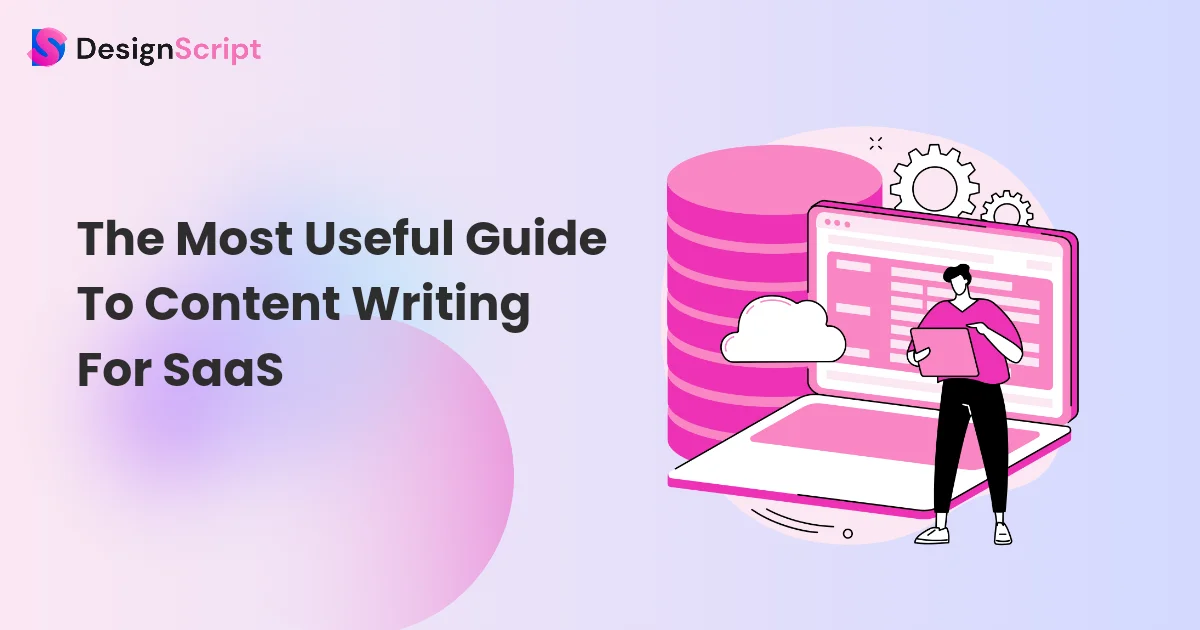Effective Strategies for SaaS Content Writing
Do you need help to make outstanding SaaS content?
You’re not alone. In fact, producing good content is a persistent difficulty for over 54% of B2B content marketers. If you are one of them, don’t worry.
This post is your secret weapon for crafting content writing for SaaS that excites your audience. It boosts engagement and leaves the audience waiting for more.
So what are you waiting for? Let’s begin.
Table of Content
- What is SaaS content writing?
- How is SaaS content writing different from other writing forms?
- Benefits of SaaS Content Writing
- Types of SaaS content writing
- Strategies for SaaS Content Writing
- Find your readers
- Use keyword research to identify important topics
- Perform SERP Analysis
- Optimize for organic traffic
- Write to satisfy search intent
- Link to relevant pages
- Use an attention-grabbing headline
- Create a compelling introduction
- Write in a conversational tone
- Show your product in real-world situations
- Keep your writing scannable
- Add effective Call to Action
- SaaS Content Writing Tools
- Content planning tools
- Content ideation & writing tools
- Content audit tools
- Google Analytics
- Content optimization tools
- Content management tools
- Role of AI in Streamlining SaaS Content Creation
- Start Attracting More Conversions With Your Content
- FAQs
What is SaaS content writing?
Forget generic blog posts and dry sales pitches. Writing SaaS content is about using words in a way that resonates with your target audience. The words should educate them about your product’s value. They should then drive them down the conversion funnel like a smooth one. The secret sauce turns website visitors into loyal customers, turning your SaaS into a cloud-based empire.
This is more than just creating content. It’s about understanding your audience’s pain points. It’s about speaking their language and building trust. It’s about adding the magic of your product, not being pushy. You must show its power in a way that ignites their “I need this!” spark.
How is SaaS content writing different from other writing forms?

Unlike traditional writing, content writing for SaaS isn’t about words. It’s about building bridges between your product and its potential users. It goes beyond informing and aims to educate, inspire, and convert. This means weaving compelling stories. They show how your product solves specific pain points and its unique value.
SEO optimization is key, making content discoverable and driving organic traffic. Tone is crucial. It balances expertise with a conversational touch. This builds trust and engagement. In essence, SaaS writing is less about self-expression. It’s about guiding readers to become loyal customers. The goal is to build a thriving online community for your SaaS.
Benefits of SaaS Content Writing

The benefits of SaaS content writing go far beyond catchy headlines and witty blog posts. It’s a powerhouse tool for attracting, nurturing, and converting leads into loyal customers.
1. Boost Brand Awareness: People can only buy what they know exists. SaaS content helps you break through the noise and reach your target audience with informative, engaging pieces that showcase your brand and its value proposition. This builds recognition and positions you as a thought leader in your industry.
2. Generate High-Quality Leads: Forget cold calls and intrusive ads. With targeted content like blog posts, ebooks, and case studies, you attract potential customers actively seeking solutions like yours. This organic traffic is more receptive and engaged, leading to higher quality leads with a genuine interest in your product.
3. Build Trust and Authority: Trust is currency in today’s digital landscape. By creating informative and valuable content, you establish yourself as an expert in your field. This establishes credibility with prospective clients and presents your company as a trustworthy source of knowledge and solutions.
4. Improve SEO and Organic Ranking: Search engines love fresh, relevant content. By consistently publishing high-quality content optimized for search engines, you improve your website’s ranking in search results. This organic visibility attracts more visitors and drives conversions without relying on paid advertising.
5. Nurture Leads and Drive Conversions: Content continues beyond attracting leads. It can also nurture them through the sales funnel. Compelling blog posts, email newsletters, and other content educate leads, address their pain points, and ultimately nudge them toward converting into paying customers.
It’s cost-effective compared to traditional marketing. Creating a valuable content library attracts leads organically. It saves you on expensive advertising costs.
Types of SaaS content writing
The SaaS landscape is ever-competitive. It would help if you had more than a great product to grab attention and drive conversions. High-quality content marketing is the fuel that propels your engine. However, so many content formats compete for attention. Choosing the right ones can be overwhelming. Therefore, we’ll dive into six key types of SaaS content writing. They will engage your audience and pave the path to success.
1. Case studies

Nothing resonates with potential customers like seeing your product in action. It solves real-world problems for real-world businesses. Case studies are your opportunity to showcase how your SaaS has transformed companies. It boosts their productivity, saves time and money, and helps them achieve their goals. Choose impactful case studies that align with your target audience’s pain points. Highlight specific features that addressed them. Share authentic testimonials to add an undeniable element of trust. Remember, a well-written case study is a compelling narrative that inspires confidence and drives conversions.
2. Checklists and listicles

In today’s fast-paced world, people need more time for dense, information-heavy content. Checklists and listicles offer a digestible, actionable approach to educating your audience. Formats like “5 Steps to Optimize Your Marketing Automation” checklists and “Top 10 Mistakes to Avoid When Launching an Online Store” listicles simplify complex topics into manageable steps and tips. They’re perfect for social media sharing, lead magnets, or adding value to your blog posts. Remember to keep them concise. Use clear language and focus on practical advice your audience can immediately implement.
3. Comparison and versus pages

Potential customers constantly compare options, and your SaaS needs to stand out. Comparison and versus pages are your chance to shine. Objectively analyze your product alongside competitors. Highlight your unique strengths and address any potential weaknesses. Focus on the features and benefits that matter most to your audience, using data and customer testimonials to back up your claims. Don’t shy away from highlighting your competitor’s shortcomings, but do so with professionalism and tact. The goal is to inform and educate, not engage in putting the competitors down.
4. Guides and walk-throughs

Onboarding new users and showing them the ropes is crucial for SaaS success. Guides and walk-throughs offer step-by-step instructions. They show you how to navigate your product, maximize its features, and achieve specific goals. Use clear, concise language with screenshots and video tutorials to make the process intuitive and engaging. Anticipate potential user questions and address them proactively. Remember, a confident and empowered user is likely to become a loyal customer.
5. Statistics posts

Statistics posts offer a powerful way to lend credibility to your content. They solidify your position as an industry authority. Use research, studies, and industry reports to highlight trends, challenges, and opportunities. Please make sure they are relevant to your target audience. Showcase how your SaaS addresses these issues by presenting data-driven results and case studies. Remember, you should present statistics visually and without manipulation. Data can be a compelling tool to persuade potential customers when used effectively. It can also help establish your SaaS as a reliable solution.
Strategies for SaaS Content Writing
In the bustling SaaS market, content is your secret weapon. It’s the bridge that connects you to your ideal customers. Writing content for SaaS platforms effectively requires a calculated approach that connects with readers and promotes company growth. Here are twelve key strategies to unlock the power of SaaS content writing:
1. Find your readers

Before writing a single sentence, understand who you’re writing for. Define your target audience with accuracy. Delve into their demographics, pain points, and aspirations.
What keeps them up at night?
What challenges are they facing?
What are their information consumption habits?
The more you know about your ideal client, the more you may adjust your content to suit their requirements and preferences. Speak their language. Address their concerns. Offer solutions that resonate with their unique reality.
2. Use keyword research to identify important topics

Keywords are the stepping stones that lead your audience to your content. To find relevant search phrases that your target audience uses, employ keyword research tools. Concentrate on low-competition, high search volume phrases. Focus on those that align with your product’s value proposition and your audience’s interests. Don’t just stuff keywords into your content. Weave them seamlessly into your narrative. Ensure your content is both informative and search-engine friendly.
3. Perform SERP Analysis

Analyze the Search Engine Results Page for your target keywords. Identify the top-ranking content and understand what makes it successful. What type of content is it? What topics do we cover? What tone does the author use? By analyzing your competitors’ content, you can gain valuable insights. You can also identify gaps you can fill with your unique perspective and expertise. Learn from their strengths, avoid weaknesses, and create content that stands out in the crowded SERP landscape.
4. Optimize for organic traffic

Keep readability in mind when you optimize your material for search engines. Improve your website’s internal linking structure to guide users to your valuable content. Leverage structured data to enhance your content’s presentation in search results. Remember, organic traffic is the life of your content strategy. The higher you rank, the more eyes you reach and the more conversions you unlock.
5. Write to satisfy search intent

Search engines are becoming sophisticated, prioritizing content satisfying user intent. Beyond keyword optimization, focus on understanding the underlying question behind each search query.
What information are users seeking?
What problems are they trying to solve?
Craft your content to address their needs. Provide clear, concise, and actionable answers. Offer valuable insights. Provide practical tips and actionable strategies. Show your expertise. Prove the value your SaaS brings.
6. Link to relevant pages

Imagine your content is a maze. You want visitors to explore every corner. You want them to discover hidden treasures like insights, tips, and solutions. Ultimately, you want them to reach the conversion. Weaving in links to relevant pages acts as a map, guiding users deeper into your offering—links to blog posts that expand on specific points. Also, case studies showcase real-world applications. And product pages let users take the next step. Remember, a clear path leads to a clearer conversion.
7. Use an attention-grabbing headline

Your headline is the first line in the content. It needs to be inviting.Use strong verbs, intriguing questions, and relevant keywords to pique their curiosity. “5 Marketing Hacks to Boost Your SaaS Signups in 24 Hours” or “Is This the Biggest Mistake You’re Making with Your CRM?” – headlines like these reel readers in and promise valuable information.
8. Create a compelling introduction

The first paragraph is your chance to cast your spell. Please don’t waste it on generic greetings or dry introductions. Instead, vividly paint the problem your audience faces. Illustrate the frustration it causes. Then, show the hope your SaaS offers. Use humor, stories, or relatable scenarios to make them connect emotionally. Remember, you are offering a solution to their pain point.
9. Write in a conversational tone

Ditch the jargon and technical terms. Speak to your audience like a trusted friend. Use natural language, humor, and personal stories. Imagine having a coffee with a potential customer. Please explain how your product would make their life easier. That’s the tone you want to capture in your writing.
10. Show your product in real-world situations

Show your audience how your product works in real-world situations. Use case studies to illustrate how your SaaS helped businesses achieve their goals. Share customer testimonials that resonate with your target audience’s challenges. Include screenshots, infographics, and short videos. They bring your product to life and make its value tangible.
11. Keep your writing scannable

Attention spans are shorter than ever, so make your content easily digestible. Short the long paragraphs with bullet points, subheadings, and bold text. Use clear language, avoiding complex sentences and vocabulary. Remember, your content should be a visual, not a block of text.
12. Add effective Call to Action

Please don’t leave your audience after providing them with valuable insights. Tell them what you want them to do next. This could be downloading an ebook or signing up for a free trial. Make your call to action clear, specific, and irresistible. Offer something valuable in return for their action. It could be a free template, a discount, or exclusive content.
SaaS Content Writing Tools
Here are a few SaaS tools for content writing,
1. Keyword research tools

A. Ahrefs
Ahrefs is a full-featured SEO toolset that includes backlink analysis, competitor analysis, keyword research, and many other capabilities. For keyword research, Ahrefs provides a vast database of keywords, their search volume, keyword difficulty, and other valuable metrics.
B. Keywords Everywhere
Using the browser plugin Keywords Everywhere, you may view keyword data immediately on search engine results pages (SERPs). It’s a great option for businesses that want a quick and easy way to see keyword data without paying a subscription to a more comprehensive SEO tool.
2. Content planning tools

A. Trello
Visualize your workflow with Trello’s intuitive boards and cards. Assign tasks and collaborate with your team. Be a content conductor with a flawless score.
B. Asana
Asana is a project management powerhouse. It offers advanced features like task dependencies, timelines, and custom fields. These keep your content calendar organized. They ensure your content symphony plays like a dream.
3. Content ideation & writing tools

A. Google Docs
The classic word processor that gets the job done. Collaborate in real-time. Access your documents from anywhere. Enjoy simple formatting options for your written content.
B. Notion
This flexible workspace is more than a document editor. Create wiki-style pages. Organize notes, embed multimedia, and build custom workflows to spark creativity. Streamline your writing process and make content creation easier.
4. Content audit tools

A. Google Analytics
Dive into the data and understand how your content performs. Track website traffic, user engagement, and conversions. Identify what’s working and what needs a tune-up.
5. Content optimization tools

A. Frase
Optimize your content for search engines. Improve reader engagement with Frase’s AI-powered suggestions. Analyze topics, keywords, and readability to ensure your content hits the right notes.
B. Rankmath
Rankmath is a WordPress SEO plugin. It simplifies on-page optimization with keyword suggestions, content analysis, and schema markup. This boosts your organic visibility, making your content shine.
6. Content management tools

A. Wix
Create stunning websites and landing pages with Wix’s drag-and-drop interface. Choose from a vast library of templates. Customize the design and publish your content in minutes. Build a beautiful stage for your content masterpiece.
B. Squarespace
Squarespace is a user-friendly website builder. It offers beautiful templates and powerful e-commerce features. It also has built-in SEO tools. These tools help you manage your content and showcase your SaaS to the world. It’s like a grand gallery for your content art.
Role of AI in Streamlining SaaS Content Creation
The age of AI in SaaS content creation is upon us. It streamlines workflows and sparks new possibilities. AI-powered tools can tackle repetitive tasks, like keyword research and content scheduling. They can even create basic writing drafts. Imagine robots churning out blog post outlines or product descriptions. This frees you to focus on strategic aspects. You can focus on audience analysis and content ideation. It also lets you add that human touch of creativity.
AI can also analyze data to identify trending topics. It can suggest personalized content for different segments. It can also optimize existing content for better search engine ranking. This doesn’t mean AI will replace human writers. It’s more like a skilled assistant, handling the repetitive tasks while you focus on the impactful ones. Embrace the AI revolution. Watch your content writing for SaaS soar to new heights faster and more efficiently than ever.
Start Attracting More Conversions With Your Content
Crafting compelling content writing for SaaS isn’t about catchy headlines and witty blog posts. It’s about building bridges between your product and potential customers. It’s a strategic dance of education, inspiration, and conversion. By understanding your audience and utilizing the right tools, you can create content that attracts and fuels your SaaS success.
So, unleash your inner content warrior. Embrace the power of this guide. Watch your SaaS content soar to new heights! Remember, the path to content mastery is a continuous journey. Experiment, refine, and track your progress. With dedication and the right tools, your SaaS content will attract more conversions. This will propel your business to the forefront of the SaaS empire.
FAQs
1. What Can SaaS Businesses Do to Generate More Conversions From Written Content?
Focus on value and engage more conversions from your SaaS content. Solve problems, answer questions, and showcase success stories. Craft clear calls to action and optimize for search. Promote strategically across social media, email, and paid ads.
2. How to do SaaS Content Promotion and Distribution the Right Way?
Think multi-channel and strategic. Share your content on relevant platforms like LinkedIn, Facebook, and email. Also, consider paid ads, and repurpose content for videos or infographics. Experiment your strategy to find what resonates with your SaaS audience.
3. How do you write content in SaaS?
Writing content for SaaS involves understanding your target audience’s pain points and crafting content that solves them. Focus on providing value, building trust, and guiding readers towards your product as the solution.

